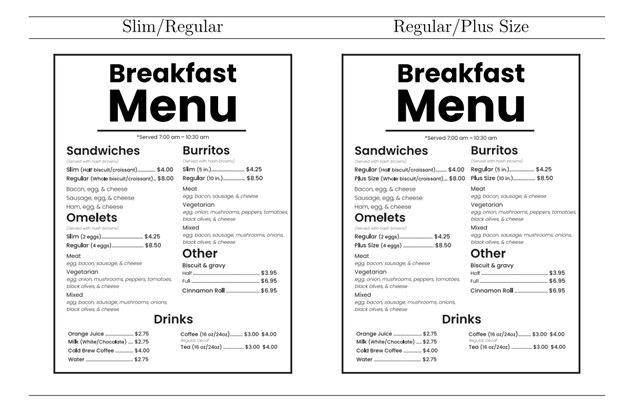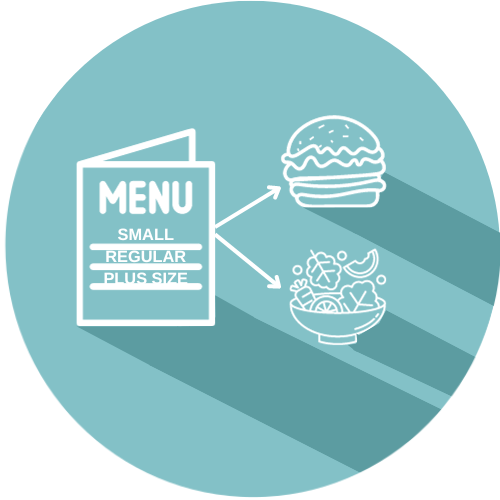Small, Regular or Plus Size? How Restaurant Menu Labeling Influences Healthy Eating
Relevant topics Archive, Strategy
Do you usually go for a “fat burger”, “super-size burger” or a “thin cookie”? These kind of labels push us to make mental associations with human body shapes and types, triggering our emotions and the way we perceive and evaluate the food we consume. A “thin cookie” implicitly suggests a small portion and lower calorie content perfect for those who work out or watch their figure. A “fat burger” caters to hedonistic needs and might appeal to people getting a kick from larger, more satisfying portions. These very words play on self-image and fitting social expectations. As humans, we tend to make choices that gain us acceptance from others we identify with and demonstrate our conformity to established norms (Van de Waal, Borgeaud, and Whiten 2013).
Body weight and body shape related words have been used for years in product design and marketing campaigns to increase the message appeal. We now know the critical role that labeling plays in our decision-making regarding food (Shi et al., 2022; Vermeir and Roose, 2020; Yarar et al., 2019), especially when we desire to become part of a special social group (Krahé and Krause, 2010). Think of McDonald’s popular ‘‘Super size’’ options during the 1990s–2000s. Or consider the Heart Attack Grill restaurant in Las Vegas, intentionally founded to serve unhealthy food (with a high chance of giving a heart attack if consumed regularly). One of their most popular burgers is labeled the “‘Octuple Bypass’’, at around 16000 KJ, making reference to bypass surgery. Customers over 350 lb (160 kg) in weight eat for free at Heart Attack Grill, if they weigh themselves on a scale before eating.
This showcases the power of social group dynamics over individual behaviour. It’s engrained in us to seek validation and approval from societal norms and ideals. Most of all, we want to feel accepted. And it also extends to our food choices (Christakis and Fowler, 2007).
The effect of health-related labels on consumer choice
Health-related labels on food products have been regulated across the U.S. and other Western countries for the last few decades to try to combat the obesity endemic and avoid misleading nutritional information. Even so, this type of regulation has only had a limited effect on consumer choice (André et al., 2019; Benson et al., 2018; Aschemann and Hamm, 2008; Kozup et al., 2003).
Marketing deployed by food companies such as Heart Attack Grill does wonders to the bottom line. But how can restaurants be profitable and influence healthy eating habits at the same time?
To increase consumption of healthy products and shape decision making, anthropomorphic labels represent a marketing opportunity that taps into consumer perception and psychology with promising results if used carefully. It is already being utilized effectively for soft drinks, with bottles that resemble attractive or desirable human body shapes, encouraging healthier food choices (Yarar et al., 2019; van Ooijen et al., 2017; Fenko et al., 2016; Karnal et al., 2016; Melbye et al., 2015).
Anthropomorphic food labels and self-image in restaurant marketing
What is so exciting and unique about anthropomorphic food labels? By making connotations to the size and shape of a food item, individuals’ ideal body image is linked to their concerns around it. It’s been shown that the results of using antropomorphic food labeling depends on one’s weight or body mass index. Individuals usually try to conform with perceived norms in their society. They will tend to pick the food option labeled as their desirable body type, such as “slim” for people with a healthy weight. Or they will avoid the dietary choices made by individuals with overweight (McFerran et al., 2010; Hermans et al., 2008).
A new field experiment set in an actual restaurant observed patrons making food choices off the menu without knowing that they are part of the research. It demonstrated that antropomorphic labeling of menu items has significant potential to impact consumer food choices, especially among people with overweight/obesity.
Two sets of experiments were performed where Small and Large portions were first labeled as Slim/Regular to reflect an ideal weight. The second test presented the menu items as Regular/Plus Size to represent a less ideal weight. (See Image below).

The Regular/Plus Size label showed the greatest difference in healthier food choice as compared to the Slim/Regular label. Highlighting the undesired (or less desired) weight in menu descriptions was the most effective in changing buying patterns toward healthier eating habits.
Trends in consumer behaviour in restaurants
Based on the research, these trends in consumer behaviour have been identified and could potentially bring about change:
- Consumers, with both normal weight and overweight/obesity, are more likely to select the smaller portion (Regular) by 14.3%.
- Individuals with overweight/obesity are 23.4% more likely to go for a small portion item when compared to the items under the Slim/Regular label.
- Where objective information was added to the menu item, such as number of eggs, size of burrito, as opposed to subjective descriptions such as for sandwiches (“half”, “whole”), smaller portions were always preferred. Individuals with overweight/obesity tend to avoid choosing the Plus Size labeled-items with numbered descriptions next to them, as they have a tendency to underestimate their weight, therefore not identifying with the Plus Size (Robinson, 2017; Gosse, 2014).
Restaurant marketing and its effect on consumer choice
When marketing a restaurant (or a food company), it pays to identify the less desirable cues that influence your customers’ perception and attention. That means, showing them what is the least desired state rather than the ideal one, and using words that make the cognitive and emotional connection in this way.
Provide customers with numeric information that will help them evaluate the menu options. Terms like ‘‘half’’ size or ‘‘whole” are open to subjective interpretation, minimizing the effect of using antropomorphic food labeling.
There are significant marketing implications for individuals with overweight/obesity when using this strategy. The vulnerable (health-wise) group of customers in this experiment has shown their motivation to distinctly prefer small portions when the menu labels communicated the least desired weight (Regular/Plus Size label), as compared to the ideal weight (Slim/Regular label).
This is an opportunity for food marketers to increase their revenue by marketing large portions as regular. Take Starbucks, for example, who uses ‘‘Grande’’ (“Large” in Italian or Spanish) for their medium size beverages. Words must be carefully considered though, as you wouldn’t want to mislead your customer base.
At the same time, there is an opportunity for restaurants and food venues to be part of the solution to the obesity epidemic by encouraging less calorie intake.
As a caveat, anthropomorphic food labels that flaunt a less desired weight can backfire. Individuals with overweight/obesity can be discouraged in their efforts to lose weight and will, in turn, consume more calories.
If operating a restaurant in the U.S., you must adhere to menu label rules (displaying calorie count), as is the case in many other Western countries. But that is not always enough to generate a shift in purchase behaviour. Other factors may drive food choice besides labeling, such as the ability to self-control, peer pressure, substituting high with low caloric foods. They must be taken into account when creating a neuromarketing campaign. You might consider running focus groups or sample surveys beforehand that could help you understand the psychological and physiological context of the campaign before launching.

